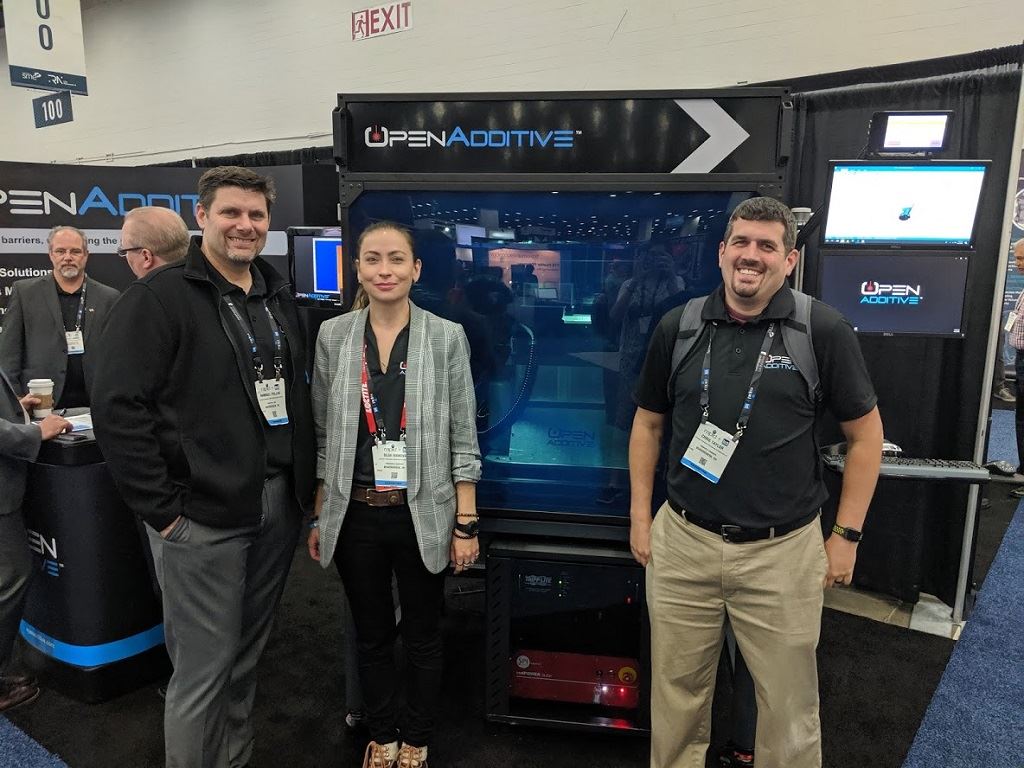![L-R: Ty Pollak, Olga Ivanova, and Chris Taylor of OpenAdditive with the Panda system [Image: Fabbaloo]](https://fabbaloo.com/wp-content/uploads/2020/05/OpenAdditive03a_img_5eb0968800c9f.jpg)
OpenAdditive is a young business focused on “the market segments left behind” with other metal additive manufacturing solutions.
Metal 3D printing: it’s new, it’s sexy, it’s exciting.
Only it’s not really any of those things. The technology has been evolving over the last couple of decades. If it’s actually manufacturing-oriented, it shouldn’t be sexy. There’s something undeniably appealing about a laser coming together with powder to create fully formed, functional objects, but in the end it should be about making things. I maintain that the excitement should spring from the fact it can be boring, rather than because it’s snazzy in and of itself.
So OpenAdditive isn’t really interested in the splash, and that shows in their functional-looking chunk of a metal powder bed 3D printer, the Panda.
A little background: OpenAdditive is the newly-rebranded name of the additive manufacturing business unit of Universal Technology Corporation (UTC). UTC, with its own roots tracing back to engineering services since 1961, established an R&D lab in 2017 called the 3D Innovation Lab. The product-focused 3D Innovation Lab sought out to explore metal and multi-material 3D printing for defense and industry (primarily aerospace) applications, and was built on an open source mindset. Partners including the University of Dayton Research Institute helped along the way, and the R&D lab has now transitioned into its own business, recently renamed OpenAdditive, which “is the unifying theme behind the research, products, and services” of UTC’s AM aims.
I spoke to Ty Pollak, PhD, Director of OpenAdditive, for more detail on the operation, and on the Panda.
“We use open architecture that’s fully configurable; we’re trying to do with laser powder bed fusion metal additive manufacturing what needs to be done,” Pollak said simply.
![Ty with the Panda system [Image: Fabbaloo]](https://fabbaloo.com/wp-content/uploads/2020/05/OpenAdditive1a_img_5eb096887b95c.jpg)
The last two years especially have seen some big changes in the metal additive manufacturing landscape, he noted. But those changes have still seen blind spots, and OpenAdditive has sprung into action to address areas they have felt are lacking.
“What’s been lacking in our view are open, configurable systems with add-ons. Systems that are usable for the customer, and that can create a user community sharing knowledge. Open systems, open parameters, that they can configure as needed,” Pollak said.
He pointed to a few of the high-level needs of metal additive manufacturing users:
-
Does it work?
-
Does it make good parts?
-
Is it economical?
-
Can we turn a profit?
Some large machines, he pointed out, have a 3-4 year return on investment (ROI) timeline, which can seem a large gap in manufacturing operations to see a usually-hefty capital investment pay off. That’s not enough for OpenAdditive.
What’s important to the team here is delivering a system to meet their needs. That’s a pretty basic standard, and so the Panda looks like a pretty basic system.
“Maybe it’s not the sexiest box around, but we’re concerned with what’s inside,” Pollak noted.
The system is boxy, sure, and definitely not the sleekest design around. One potential customer who visited OpenAdditive’s facility in Dayton, Ohio asked if they were sure the machine wasn’t a prototype. It’s pretty boxy, pretty basic. But, importantly: it works.
![The boxy Panda, with a safety window to view the process, and a few polymer 3D printed components in the back visible [Image: Fabbaloo]](https://fabbaloo.com/wp-content/uploads/2020/05/OpenAdditive02a_img_5eb09688d7d3f.jpg)
The Panda is a laser-agnostic system that can use adaptive or off-the-shelf optics. It includes an internal subtractive laser for selective laser ablation machining (SLAM) during the build. The system runs an inert environment, enabling work with reactive metals. The system also has about 40 parts on it that were themselves 3D printed, and provides STL files for all of them for users to reproduce or reconfigure. It’s also designed to be “facility friendly: If you have a double door and a 220V outlet, you’re good to go,” Pollak noted.
Most importantly, what you see is what you get: “There’s no closed curtain.”
The price point is relatively in line with what one might expect: including a sensor package, the price point is $299,000 ($50K less without the sensor package) and “includes everything but travel to the site to install it.”
Per OpenAdditive, their systems include:
Commercially available now:
-
Panda — 6″x6″ (~150 mm) class
Coming soon (in development/evaluation):
-
Grizzly — 11″x11″ (~280mm) class
-
Hippo — 16″x16″ (~400mm) class
-
Mammoth — 24″x24″ (~600mm) class
We can expect to see the Grizzly and Hippo emerge this year; the Grizzly will be priced around $350K, and the Hippo at $550K. All of the systems are designed to be “very modular; they can be configured three different ways for three different customers.”
Those different customers will indeed have different needs. Going back to Pollak’s point about the “market segments left behind” in metal 3D priting, OpenAdditive is looking to target the needs of machine shops, research facilities, community colleges, and others looking for customizable metal part production.
The first two systems have recently been installed, one just before RAPID + TCT and one just after. Half of the 20-person team trekked to RAPID between the installations to showcase the Panda.
The company has partners in community colleges, universities, and production operations to continually gain feedback. We’ll also see more news about partnerships as OpenAdditive gains momentum and can be more vocal about its activities. Those activities will be even more public at next year’s RAPID, as the company notes that they have already secured “3x more floor space” for the 2020 event.
“We think the industry needs a fresh approach. There’s always going to be room for closed production, for turnkey systems, but we also need something more,” Pollak said.
Via OpenAdditive

